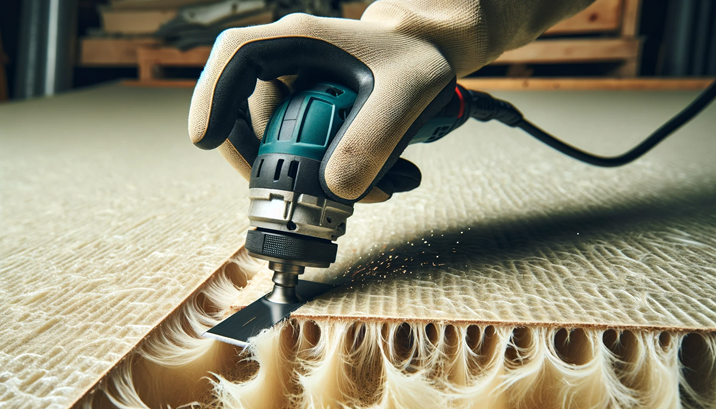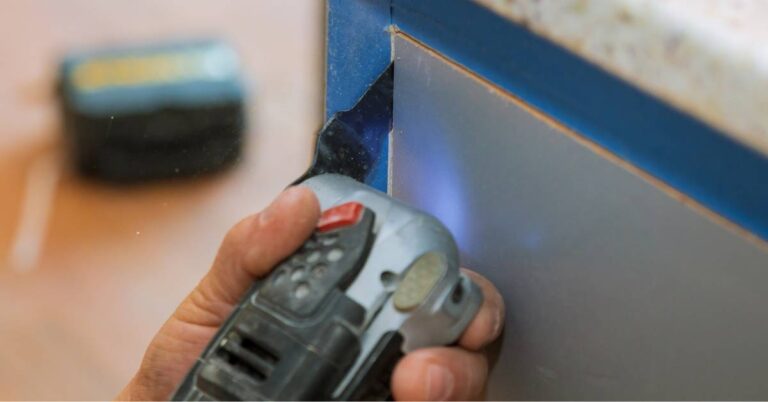Unlocking the Potential of Oscillating Tools in Fiberglass Applications
Introduction
Introduction Fiberglass is a versatile and widely used material in various industries, including construction, automotive, aerospace, and marine.
Its unique properties make it ideal for applications where strength, durability, and resistance to corrosion are essential. However, due to its composition and structure, working with fiberglass can be challenging.
This is where oscillating tools come into play. With their multi-functionality and precision, these tools have the potential to revolutionize fiberglass fabrication and repair processes.
Maximizing efficiency with oscillating tools in fiberglass tasks can significantly enhance productivity and quality. Unlike other power tools that may cause excessive vibration or heat generation when working with fiberglass, oscillating tools offer a more controlled approach.
Their gentle yet powerful oscillation allows for precise cutting and shaping without compromising the integrity of the material. Effective attachments designed specifically for fiberglass are crucial to achieving optimal results when working with this material using oscillating tools.
Manufacturers now offer a variety of blades that cater specifically to fiberglass cutting requirements. These blades typically feature fine-tooth patterns or diamond grit coatings to minimize splintering while ensuring clean cuts through the composite layers.
One of the standout advantages of oscillating tools in fiberglass work is their versatility. These compact devices can perform multiple functions- cutting, sanding, scraping, grinding, and polishing – all within a single tool body.
This eliminates the need for switching between different power tools during a project and streamlines the workflow. Utilizing oscillating tools in fiberglass applications opens up new possibilities for precision quality and efficiency.
Selecting proper blades tailored for cutting or shaping fibreglass materials and adhering to safety guidelines when operating these devices on delicate surfaces like composites ensures optimal results without compromise. In subsequent sections of this article, we will delve deeper into selecting the right tool attachments for specific tasks and exploring advanced techniques that unlock the true potential of these versatile instruments in fiberglass fabrication processes.
Understanding Fiberglass as a Material
Fiberglass, a versatile and widely used material in various industries, is a composite of glass fibers embedded in a polymer matrix. A comprehensive understanding of fiberglass is crucial to truly unlocking the potential of oscillating tools in fiberglass applications.
First and foremost, fiberglass offers an exceptional strength-to-weight ratio, making it ideal for applications where weight reduction is paramount. This characteristic allows oscillating tools to cut through fiberglass with precision and effortlessly.
The best blades for cutting fiberglass with oscillating tools are those specifically designed for this material. These blades typically feature fine-toothed designs that minimize splintering and ensure clean cuts.
Precision is vital when working on fiberglass projects, as even minor errors can compromise the integrity of the final product. Oscillating tools shine in this regard because they can provide meticulous control over cutting depth and speed.
Guidelines for operating an oscillating tool on fiberglass include maintaining a steady hand and using light pressure to avoid chipping or cracking the material. One of the most significant advantages of oscillating tools in fiberglass fabrication is their versatility.
These multi-tools can tackle various tasks such as cutting, grinding, sanding, scraping, and even polishing – all within the confines of a single device. This versatility significantly reduces the need for multiple specialized tools and amplifies efficiency across different stages of fiberglass work.
When shaping fiberglass, oscillating tools offer unmatched precision compared to traditional saws or rotary tools. Different techniques can be employed with an oscillating tool depending on the desired result—whether it’s creating intricate curves or precise notches.
By selecting attachment accessories specifically designed for shaping fiberglass surfaces, such as carbide-tipped blades or sanding pads with high grits, remarkable results can be achieved smoothly and efficiently. In addition to its fabricational benefits, these multi-tools repair damaged fiberglass material sections.
Whether patching cracks, reinforcing weak spots, or replacing broken sections, oscillating tools equipped with appropriate blades and accessories can seamlessly carry out fiberglass repair work. This versatility ensures that fiberglass projects remain strong and durable over time.
Understanding the various advantages of oscillating tools in fiberglass applications is essential for maximizing efficiency. By selecting the right attachments for specific tasks, such as plunge-cutting blades or grout removal accessories, one can ensure optimal performance in every endeavour.
Furthermore, regular maintenance and care of the oscillating tool will guarantee longevity and consistent operation. In the next section of this article, we will delve into selecting the right oscillating tool and blade for fiberglass applications to further enhance your expertise in harnessing the true potential of these versatile tools.
Why Choose an Oscillating Tool for Fiberglass?
When working with fiberglass, an oscillating tool is versatile and efficient, with numerous advantages. Its unique oscillating motion makes it ideal for cutting, shaping, and repairing fiberglass tasks. One of the main advantages of using an oscillating tool in fiberglass fabrication is its precision cutting capabilities.
Unlike traditional power tools like saws or rotary tools, which may create excessive vibration or generate heat that can damage the delicate fibers of fiberglass, oscillating tools offer a controlled and precise cutting action. This allows for clean and accurate cuts without compromising the material’s structural integrity.
Regarding operational guidelines for using oscillating tools on fiberglass, selecting the appropriate blade for the task at hand is crucial. When cutting through fiberglass sheets or panels, opting for a fine-toothed blade with carbide grit or diamond coating is recommended.
These blades will provide a smooth and controlled cut without causing fiber fraying or splintering. Maintaining a steady hand while operating the tool is also important to avoid applying excessive pressure that could crack or break the fiberglass.
To maximize efficiency when working with oscillating tools in fiberglass tasks, it’s worth considering attachments specifically designed for this material. For instance, specialty blades available have been engineered with features like reinforced teeth or serrated edges to enhance performance on fiberglass surfaces.
Additionally, some manufacturers offer vacuum attachments connected to the tool to remove dust and debris during operation, ensuring better visibility and cleaner work areas. Choosing an oscillating tool as your go-to instrument for working with fiberglass offers multiple benefits.
From its precision cutting capabilities to its versatility in various tasks such as shaping and repair work, there’s no denying that an oscillating tool holds immense potential in this field. By following operational guidelines and selecting appropriate blades and attachments designed specifically for use on fiberglass surfaces, you can unleash the full power of these tools, achieving outstanding results and ensuring a safe and efficient fiberglass fabrication process.
Selecting the Right Oscillating Tool and Blade
When selecting the right oscillating tool and blade for fiberglass applications, there are a few key factors to consider. The efficiency and effectiveness of your work will significantly depend on choosing the appropriate tool and blade combination. Here are some guidelines to help you make an informed decision:
1. Fiberglass-specific Blades: To achieve precise cuts in fiberglass, it is essential to use blades specifically designed for this material. Look for blades with fine teeth that can cleanly cut through fiberglass without splintering or causing damage.
Bi-metal or carbide-tipped blades are popular choices due to their durability and ability to withstand fiberglass’s abrasive nature.
2. Blade Oscillation Speed: The speed at which the blade oscillates also plays a crucial role in achieving optimal results in fiberglass applications.
Consider using an oscillating tool with variable speed settings for delicate tasks requiring more control, such as intricate shaping or detail work. This feature allows you to adjust the oscillation speed according to your project’s requirements.
3. Multi-tool Versatility: One advantage of using an oscillating tool in fiberglass fabrication is its versatility. Seek out models that offer interchangeable attachments, as these tools can be utilized for cutting, sanding, grinding, scraping, and more.
A multifunctional tool will enable you to tackle different project stages without needing multiple tools cluttering your workspace. Additionally, it is crucial to prioritize safety when operating an oscillating tool on fiberglass.
Always wear appropriate personal protective equipment (PPE), such as safety goggles, gloves, and a dust mask, particularly when cutting or sanding fiberglass materials that may release harmful fine particles if inhaled. By carefully selecting the right oscillating tool and blade combination for your specific fiberglass application needs while adhering to proper safety measures, you can maximize efficiency and achieve professional-grade results in projects involving this versatile material.
Safety First: Working with Fiberglass
Safety First: Working with Fiberglass Precision cutting in fiberglass projects requires the utmost attention to safety as the material can produce fine, airborne particles that pose health risks if inhaled or come into contact with the skin.
When using oscillating tools on fiberglass, it is essential to follow specific safety tips to protect yourself and ensure a successful outcome. First and foremost, wearing appropriate personal protective equipment (PPE) is crucial.
This includes safety glasses or goggles to shield your eyes from flying debris, a dust mask or respirator to filter out harmful particles, and gloves to protect your hands from potential cuts or irritation. Additionally, consider wearing long-sleeved clothing and covering exposed skin to minimize direct contact with the fiberglass.
Another critical aspect of working safely with an oscillating tool on fiberglass is proper handling and operation techniques. Please familiarize yourself with the manufacturer’s guidelines for using the tool on fiberglass materials, as they may provide valuable insights into optimum operating speeds, pressure requirements, and other crucial details.
Various options are available for practical oscillating tool attachments for working on fiberglass. For precision cutting tasks such as trimming edges or creating intricate shapes in fiberglass panels, a narrow-toothed blade specifically designed for fiberglass is advisable.
These blades typically have small teeth that minimize splintering and ensure clean cuts without damaging the material. Working safely with an oscillating tool when handling fiberglass is of paramount importance.
By following safety guidelines such as wearing appropriate PPE and adopting proper handling techniques, you can protect yourself from potential hazards while maximizing efficiency in your fiberglass projects. Selecting suitable attachments like narrow-toothed blades designed for precise cutting enhances both safety and quality of artistry when using oscillating tools on this versatile material.
Preparing for the Job
Preparing for the job When working with fiberglass, proper preparation is crucial to ensure a smooth and successful project. Before diving into your task, you should take several key steps to prepare yourself and your work area.
Firstly, make sure you have all the necessary safety equipment on hand. Fiberglass can release fine particles that irritate the skin, eyes, and respiratory system.
Therefore, wearing protective clothing such as long-sleeved shirts, gloves, safety goggles, and a dust mask is essential. Additionally, ensure that your work area is well-ventilated to minimize the inhalation of fiberglass dust.
Next, consider the unique advantages of using oscillating tools in fiberglass fabrication. Oscillating tools provide precise control and versatility in various applications — from cutting and shaping fiberglass panels to removing old layers during repairs.
Familiarize yourself with the specific capabilities of your oscillating tool model and consider obtaining any additional attachments or blades designed explicitly for fiberglass work. Once you have gathered all the necessary equipment and familiarized yourself with your oscillating tool’s capabilities for fiberglass tasks, it’s time to prepare the surface you will be working on.
Start by cleaning the fiberglass thoroughly to remove any dirt or debris that could interfere with the cutting or shaping processes. A mild soap solution can do the job effectively without damaging the material.
By taking these preparatory measures seriously, you will set yourself up for success in working with fiberglass using an oscillating tool. Remember that safety should always be a top priority when handling this material; therefore, don’t hesitate to review the guidelines for operating an oscillating tool on fiberglass before proceeding further.
Practical Techniques for Cutting and Shaping Fiberglass
When cutting and shaping fiberglass, oscillating tools offer several advantages over traditional cutting methods. Their precision and versatility make them a go-to choice for professionals and DIY enthusiasts. Whether working on a fiberglass fabrication project or making repairs, mastering effective techniques for cutting and shaping fiberglass with an oscillating tool is crucial.
To achieve precise cuts in fiberglass projects, it is important to select the proper blade attachment for your oscillating tool. A bi-metal or carbide-tipped blade is ideal for cutting through the tough fibers of fiberglass without dulling quickly.
These blades are designed to withstand high temperatures generated during cutting, ensuring longevity and efficiency. When operating an oscillating tool on fiberglass, specific guidelines must be followed to provide safety and optimal results.
First and foremost, always wear appropriate personal protective equipment such as safety glasses, gloves, and a dust mask. Fiberglass particles can be harmful if inhaled or come into contact with the skin.
Secure the workpiece firmly to prevent unintended movements during the cutting process. In terms of technique, start by marking your desired cut line on the fiberglass surface using a pencil or marker.
When cutting through thicker sections of fiberglass, it is recommended to use multiple shallow passes rather than attempting a single deep cut. This approach reduces stress on the blade and helps maintain better control over the tool.
Oscillating tools with sanding attachments prove invaluable for intricate shaping tasks in fiberglass projects. These attachments allow you to smooth edges, refine curves, and create intricate contours with ease.
You can achieve professional-quality results by selecting sandpaper grits appropriate for your desired finish—ranging from coarse grits for rapid material removal to finer grits for a polished look. Utilizing effective techniques when using oscillating tools in fiberglass applications can significantly enhance precision cutting and shaping outcomes while optimizing overall efficiency.
By carefully selecting appropriate blade attachments, following safety guidelines, and employing proper cutting and shaping techniques, you can unlock the full potential of oscillating tools in your fiberglass projects. Whether engaged in fabrication or repair work, an oscillating tool is a versatile companion that enables you to achieve remarkable results in your fiberglass endeavours.
Advanced Applications
Regarding advanced applications in fiberglass work, oscillating tools truly showcase their versatility and efficiency. With the proper techniques and attachments, these tools can help achieve precision cuts and shapes, making them an invaluable asset in various projects. This section will explore advanced applications where oscillating tools excel in fiberglass fabrication and repair.
One remarkable advantage of oscillating tools in fiberglass fabrication is their ability to make precise cuts. Users can achieve clean and accurate cuts without damaging the material by selecting the best blades for fiberglass cutting, such as carbide-tipped or diamond-coated blades.
The oscillating motion of these tools ensures minimal splintering or chipping along the edges, resulting in a professional finish. In addition to precision cutting, oscillating multi-tools are ideal for repairing damaged fiberglass components.
Whether fixing cracks or performing patchwork, these versatile tools can efficiently remove damaged sections without disturbing the surrounding areas. Users can seamlessly blend new layers into existing structures by utilizing guidelines for oscillating tool operation on fiberglass repair, such as working at low speeds with gentle pressure.
Moreover, oscillating tools provide excellent maneuverability and control when it comes to intricate shaping tasks in fiberglass projects like creating curves or bevelled edges. Their compact design allows access to tight spaces and corners that other power tools may struggle with.
By employing practical oscillating tool attachments for fiberglass shaping, like rasps or sanding pads specifically designed for this material, artisans can easily sculpt intricate contours while maintaining desired precision levels. Harnessing the potential of oscillating tools greatly benefits advanced applications in fiberglass work.
Their precision cutting capabilities with specialized blades ensure clean edges while minimizing damage to the material. For repairs on damaged surfaces or patchwork jobs involving fiberglass components, these multi-tools offer versatility and efficiency unmatched by other equipment options.
Furthermore, when it comes to intricate shaping tasks that require meticulous attention to detail, oscillating tools equipped with suitable attachments provide the agility and control necessary for achieving professional results. By understanding the best practices and safety guidelines, artisans can maximize the efficiency of these tools in various fiberglass applications.
Maintenance and Care of Oscillating Tools
Maintenance and Care of Oscillating Tools Proper maintenance and care are crucial for ensuring the longevity and optimal performance of your oscillating tools when working with fiberglass.
Following a few guidelines, you can keep your tool in excellent condition while maximizing its efficiency and effectiveness in fiberglass tasks. first, cleaning your oscillating tool regularly after each use is essential.
Dust, debris, and resin accumulation can hinder the tool’s performance over time. Start by unplugging the device and using a soft brush or compressed air to remove excess material from its body and components.
Be thorough in cleaning hard-to-reach areas such as crevices, vents, and attachment mechanisms to prevent clogging or malfunctioning. Additionally, pay close attention to the blades or attachments used for fiberglass cutting with oscillating tools.
Due to fiberglass’s abrasive nature, these components may wear out faster. Inspect them regularly for signs of wear, such as dullness or chipping, and replace them promptly if necessary.
Using damaged blades reduces cutting precision and puts unnecessary strain on your oscillating tool’s motor. Consider using carbide-tipped blades or diamond-coated sanding pads for practical oscillating tool attachments designed for fiberglass tasks.
These attachments are known for their durability when cutting through fiberglass materials while maintaining precision. Furthermore, compared to standard blades, these specialized accessories can reduce heat buildup during operation, minimizing the risk of damage to both the material being cut and the oscillating tool itself.
By adopting these maintenance practices and investing in appropriate attachments for your oscillating tools’ specific applications in fiberglass work, you will enhance their longevity and ensure consistent performance throughout your projects. Proper care will enable you to tackle intricate precision-cutting tasks efficiently while maintaining safety.
Proper care of oscillating tools is essential when working with fiberglass materials. Regular cleaning helps prevent dust and debris from compromising the tool’s performance, and inspecting and replacing blades or attachments as needed ensures optimal cutting precision.
Using specialized attachments designed for fiberglass tasks, such as carbide-tipped blades or diamond-coated sanding pads, can significantly enhance both efficiency and safety. Incorporating these maintenance practices into your routine will ensure that your oscillating tools unlock their full potential in fiberglass fabrication and repair projects while remaining in top condition for years to come.
Conclusion
As we conclude this comprehensive exploration of unlocking the potential of oscillating tools in fiberglass applications, it is evident that these versatile tools offer numerous advantages in fiberglass fabrication. Their precision cutting and shaping capabilities and multi-tool versatility make them an invaluable asset for any craftsman or DIY enthusiast working with fiberglass.
Throughout this article, we have delved into various aspects of using oscillating tools on fiberglass. We have discussed the best blades for cutting and shaping, highlighted effective techniques for achieving precise results, and emphasized the importance of safety when operating these tools.
By adhering to operating guidelines and implementing proper maintenance and care practices, users can maximize efficiency in their fiberglass tasks. One cannot underestimate the significance of oscillating tool attachments specifically designed for fiberglass work.
These accessories enhance the functionality of these versatile tools by offering specialized features such as increased durability and extended blade life. Incorporating these attachments into your arsenal will undoubtedly elevate your craftsmanship to new heights.
Utilizing oscillating tools in fiberglass applications opens up many possibilities for professionals and enthusiasts alike. These efficient devices offer unparalleled precision and versatility, from intricate repairs to complex fabrication projects.
By harnessing their power while following established safety protocols, you can confidently embark on your journey in fiberglass work and achieve exceptional results every time. So go forth—unleash your creativity upon this resilient material—and let the potential of oscillating tools be your guiding force toward success.




